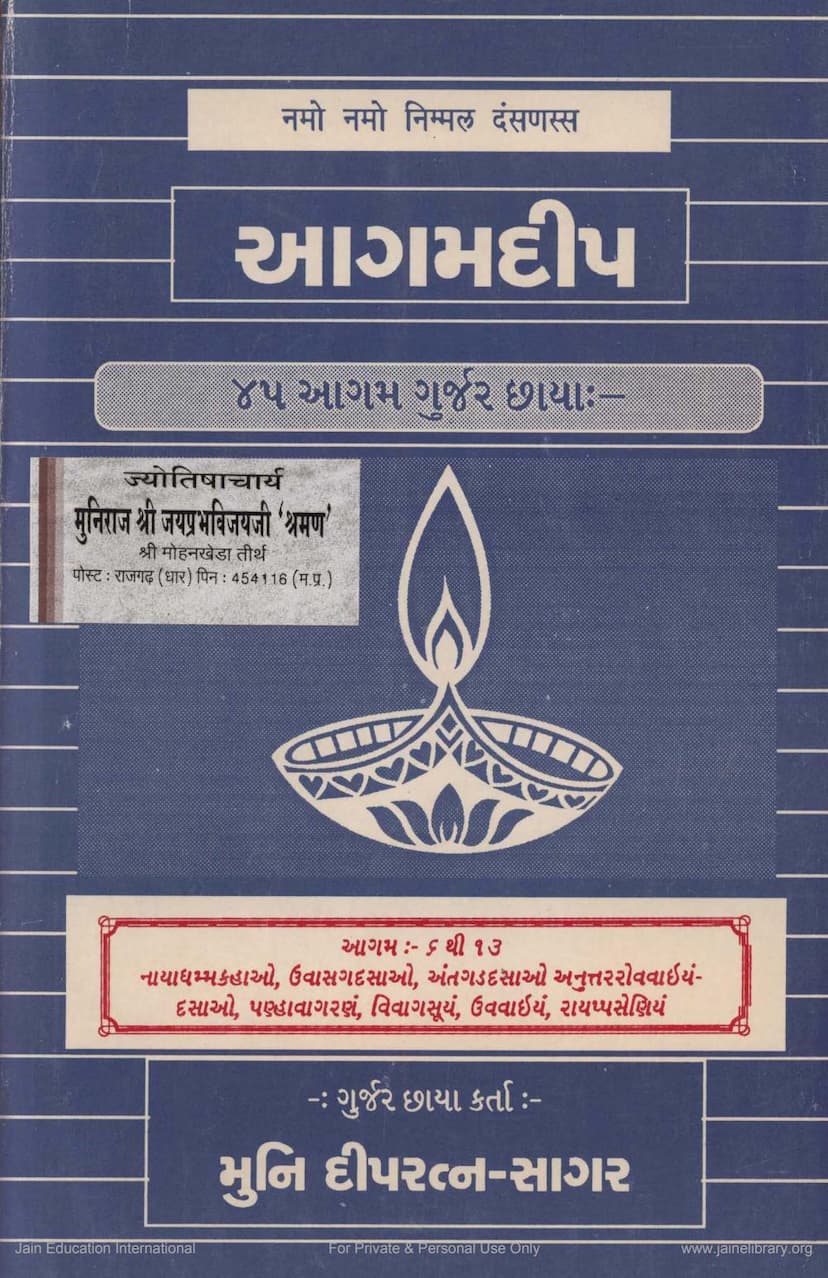Agam Deep Agam 06 To 13 Gujarati Anuvaad Part 3
Added to library: September 1, 2025

Summary
This document is the Gujarati translation and commentary (Anuvaad Part 3) of Jain Agam texts, specifically volumes 06 to 13, translated and commented upon by Muni Deepratnasagar. The publisher is Agamdip Prakashan. The catalog link provided is https://jainqq.org/explore/005056/1. The text is stated to be for private and personal use only.
The content appears to be a detailed breakdown of several Jain scriptures, specifically focusing on the "Angas" (canonical texts). The following texts are listed as being translated and commented upon in this volume (which is designated as Part 3 of the Gujarati Anuvaad of Agama Deep, volumes 06 to 13):
- Naya Dhammakahaao (નાયાધમ્મકહાઓ): The 6th Anga Sutra, Gujarati translation.
- Uvasaga Dasaao (ઉવાસગદસાઓ): The 7th Anga Sutra, Gujarati translation.
- Antagad Dasaao (અંતગડ દસાઓ): The 8th Anga Sutra, Gujarati translation.
- Anuttarauppavaiy Dasaao (અનુત્તરઉપવાઈય દસાઓ): The 9th Anga Sutra, Gujarati translation.
- Pahavagaran (પહાવાગરણ): The 10th Anga Sutra, Gujarati translation.
- Vivagasuya (વિવાગસૂર્ય): The 11th Anga Sutra, Gujarati translation.
- Uvavaiya (ઉવવાઇય): The 1st Upanga Sutra, Gujarati translation.
- Rayapasaniya (રાયપસણીય): The 2nd Upanga Sutra, Gujarati translation.
The subsequent pages provide a table of contents or an index of the chapters and their corresponding page numbers within the text. It seems to be an exhaustive index, detailing the specific sections or "adhyayana" (studies) within each Anga Sutra. For example, for Naya Dhammakahaao (6th Anga), it lists sections like Sanghat, Andak, Karma, etc., along with their page numbers. Similarly, it lists the contents for Uvasaga Dasaao (7th Anga) and Antagad Dasaao (8th Anga).
The later pages then provide a narrative summary or explanation of specific chapters, starting with the first chapter of Naya Dhammakahaao (Niyayadhamma Kahaa). This summary appears to be a detailed explanation of the stories and teachings within that particular chapter, covering the dialogue between Gautam Swami and Bhagavan Mahavir regarding the story of Meghakumar.
Key themes and structure:
- Agam Literature: The document is dedicated to explaining the Agam literature of Jainism, specifically the Anga Sutras.
- Gujarati Translation and Commentary: The primary goal is to provide the Gujarati translation and commentary ("Gurjar Chhaya") of these sacred texts.
- Detailed Chapter Breakdown: The initial pages offer a meticulous index of the chapters within each of the mentioned Anga Sutras, indicating the specific topics or sections covered.
- Narrative Explanation: The core of the document provides detailed summaries and explanations of individual chapters. For the first chapter of Naya Dhammakahaao, it delves into a story, likely illustrating Jain ethical and philosophical principles.
- Genealogical and Life Story Elements: The narrative summaries, like the one for Naya Dhammakahaao, often include details about the characters' past lives, their actions, and the consequences of those actions, which are central to Jain teachings on karma and liberation.
- Spiritual Guidance: The explanations likely aim to guide the reader on the path to spiritual development, liberation (Moksha), and understanding the Jain worldview.
Specific Narrative Example (Naya Dhammakahaao, Chapter 1): The summary of the first chapter of Naya Dhammakahaao focuses on the conversation between Lord Mahavir and his disciple Gautam Swami. It begins with Lord Mahavir explaining the significance of the 6th Anga, Naya Dhammakahaao. The narrative then unfolds into the story of Meghakumar, tracing his past lives and the actions that led to his current circumstances. It illustrates key Jain concepts such as: * Karma: The consequences of actions, both positive and negative, are shown through the cycle of rebirth and the suffering experienced by beings. * Transmigration: The text highlights the journey of the soul through various lifetimes and forms. * Spiritual Progress: The narrative emphasizes the importance of virtuous actions, penance, and right faith (Samyak Darshan) in attaining liberation. * Cause and Effect: The story of Meghakumar's past deeds and their impact on his present situation serves as a lesson on the law of karma. * Asceticism and Renunciation: The text likely portrays the path of renunciation and spiritual discipline as the means to overcome suffering and achieve Moksha.
In essence, the document serves as a scholarly and spiritual resource for understanding core Jain scriptures in Gujarati, providing detailed explanations of narratives and teachings within the Anga Sutras.